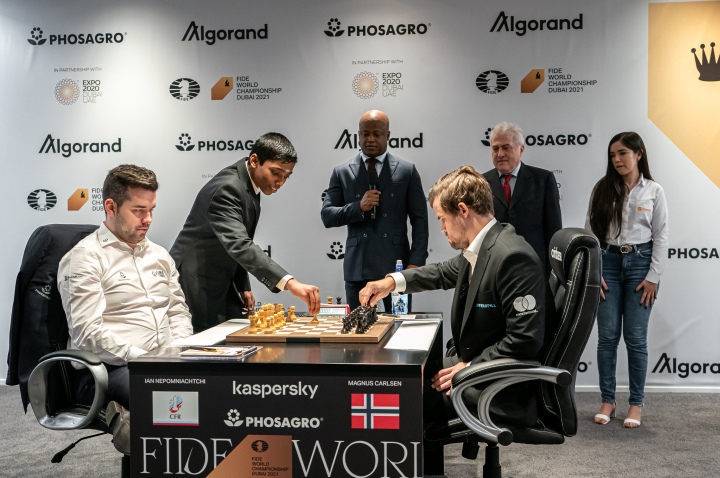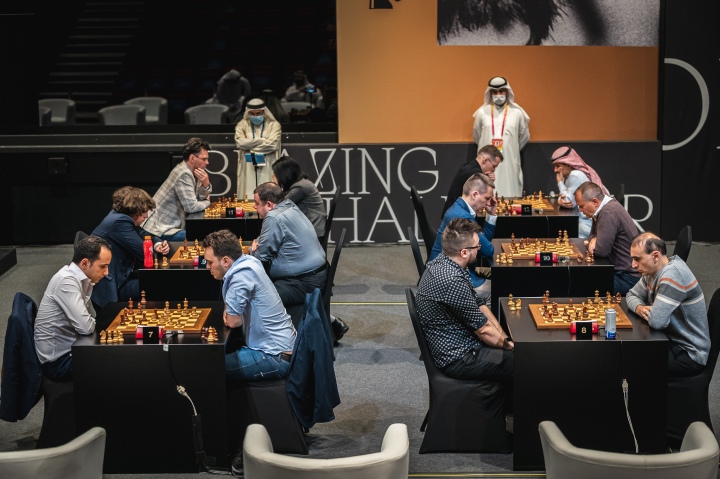FIDE World Championship 2021: Hindsight is not enough

Damage improvisation This year’s FIDE World Championship has entered the crisis stage. After eight games the often invincible champion, Magnus Carlsen, has taken a 5-3 lead in his 14-game title defence against challenger Ian Nepomniachtchi. Besides holding the elite record for longest undefeated streak – 125 games – Carlsen has only lost a total of two games in world title matches since his successful challenge versus holder Vishwanathan Anand in 2013. Dubai is the Norwegian’s fifth title match. Now there are two games in town for fans and pundits – the first: trying to anticipate how Nepomniachtchi will ramp up the complexity and risk levels to create the kind of chaos that is seen as his forte, but which has been viewed as too dangerous while the match was in equilibrium. Aficionados are voicing their hopes, wishing for wild, romantic, sacrificial openings of bygone times to try and unsettle the champion. Pragmatic pundits dismiss this type of overblown reaction as suicidal, and a match-shortener – but they do agree that the time has come to cast aside his so-far preferred quiet opening weaponry and take up something harder to neutralise. True confessions During the rest day Carlsen spoke to another Magnus, Barstad – a friend and podcast partner who the champion dubbed ‘part music expert, part fashion expert, hype man’ – and revealed some of his feelings about the match before game nine. “I have to expect that the match will enter a phase that will be a bit different. A desperate opponent is a very dangerous opponent. I expect that he has regrouped on the rest day and will bounce back strongly now.” Carlsen also confessed that he had found the last set of three games gruelling: “It’s been a recurring theme the last few days that I’ve felt tired, and it’s been exhausting. But I’ve been repeating to myself: ‘It’s worse for him! It’s worse for him!’” Time is running out for the challenger, who does indeed need to recharge and find himself; both his best form and the creativity that has made him a fearsome opponent. The real match strategy? The second game that match-watchers play is reading and assessing the overall match strategy. This becomes particularly tempting when the favourite seizes a sizeable lead, and the challenger is counted out with nearly half the match left to play. Hindsight is an essential ingredient of this kind of match interpretation, though it is worth emphasising even then, there will be eternally mysterious aspects, never fully understood without input from the players themselves. When the Dubai battle stood deadlocked after five draws, there were some very easy ‘conclusions’ to reach from reading between the lines of the games. Since none of the games ended decisively, and Carlsen was taking far more risks in the opening, a simple read was that Nepomniachtchi, aided by former challenger Sergey Karjakin, was adopting his compatriot’s strategy, which nearly toppled Carlsen in New York 2016, namely: frustrate the relentless champ with a series of draws, and hit him when his ambition led him to overreach. A close examination of game six – a game packed with enough moves for three full fights – implies a very different picture. Bravery and fate While much of that record-long marathon showed the trademark grim determination of the champion to battle until the board is bare of ideas, it was anything but a remorseless, relentless win. It was a see-saw brawl at the beginning, with both players searching for ways to inject fuel and keep the struggle lit, despite plenty of potential for the game to fizzle out. The nerve-jangling mutual race to reach move 40 without exceeding the time limit, and instantly forfeiting the game, contained a number of subtle swings in fortune, and later a few hasty decisions from Ian would turn the contest in Carlsen’s favour. There is a strong argument that this pivotal battle, so exhausting that it would be felt for days, was not decided by the usual chess factors, but by nerve and concentration. And it wouldn’t have happened without ambition from the challenger as well. Only they know for sure The ease with which hindsight not only informs, but also judges, should be regularly tested. Another glib assessment is that Nepo’s moments of indecision in some of the early games could be due to having a conservative match strategy from 2016 tugged onto him like an ill-fitting suit. The ‘Karjakin strategy’ has had years to settle as something approaching fact; but how much sense does it really make? It seems far more likely that the Sergey’ Minister of Defence’ Karjakin persona was forged there simply as a result of survival, and that the long series of often uphill draws in 2016 was due to Carlsen consistently creating pressure yet not quite converting. Karjakin showed no hesitation in pushing when he got something to work with. Did he really turn up planning to take days of endless punishment from the world’s foremost punisher? In any event, game six here is at least grounds for the serious argument that, even if a ‘Plan Karjakin’ existed, version 2.0 wasn’t firmly in force in Dubai. If it had been, game six would likely have taken a very different course. Schrödinger’s weapon Match strategies are complex and private, and presumably adjustable according to circumstance. Fateful decisions simply have to be made and lived with. Preparations and contingency plans are a bit like Schrödinger’s cat, both good and bad, defined by what emerges at the end. The loser of a match finds out they packed a faulty potato gun, even though both teams will absolutely swear they put Schrödinger’s laser cannon in that box when they set off. The ritual start The ceremonial start of game nine had the strongest chess representation of the event, with Indian prodigy GM Rameshbabu Praggnanandhaa, one of the top-ranked youngsters in the world, making the first move. He was joined by Deputy FIDE President Bachar Kouatly, and Ayelen Martinez, organiser of
Sheikh Hamdan bin Rashid Cup kicks off in Dubai

Sheikh Hamdan Bin Rashid Cup in honour of the late Sheikh Hamdan Bin Rashid Al Maktoum, the former Deputy Ruler of Dubai and UAE Minister of Finance and Industry, organized by Dubai Chess and Culture Club is underway in Dubai. The international chess tournament is also a tribute to one of the biggest sports patrons of Dubai and the UAE. A total of 24 invited elite grandmasters are competing for the $30,000 in total prize fund at the venue of the world’s most significant events taking place this year: the FIDE World Championship match between Magnus Carlsen and Ian Nepomniachtchi and the Expo 2020 in Dubai. This includes a $9,000 fund allocated for prizes for female players. The line-up of the tournament includes Vladislav Kovalev (FIDE), Parham Maghsoodloo (Iran), Salem A.R. Saleh (UAE), Vladimir Fedoseev (Russia), Bassem Amin (Egypt), Loek van Wely (Netherlands), Hans Moke Niemann (USA) and two female players Zhansaya Abdumalik (Kazakhstan) and Irene Kharisma Sukandar (Indonesia). The event is taking place from 6–9 December 2021 at the Expo 2020 Dubai Exhibition Centre. During the first three days of the Sheikh Hamdan Bin Rashid Cup, players compete in the nine-round Swiss System tournament with 15 minutes for the entire game, plus a 10-second increment starting from move one. On Thursday, December 09, 11 rounds of blitz (3 min + 2 sec/move) will be played. After six rounds of play, Hans Moke Niemann and Vladimir Fedoseev are sharing first place with five points each. So far, the American has been undefeated, whereas the Russian compensated for his single loss with five victories. The leaders are followed by Bartosz Socko and Vladislav Kovalev sitting on 4 points. All the results, standings and pairings can be found here. Photo: Eric Rosen Official website: dubaichess.ae

